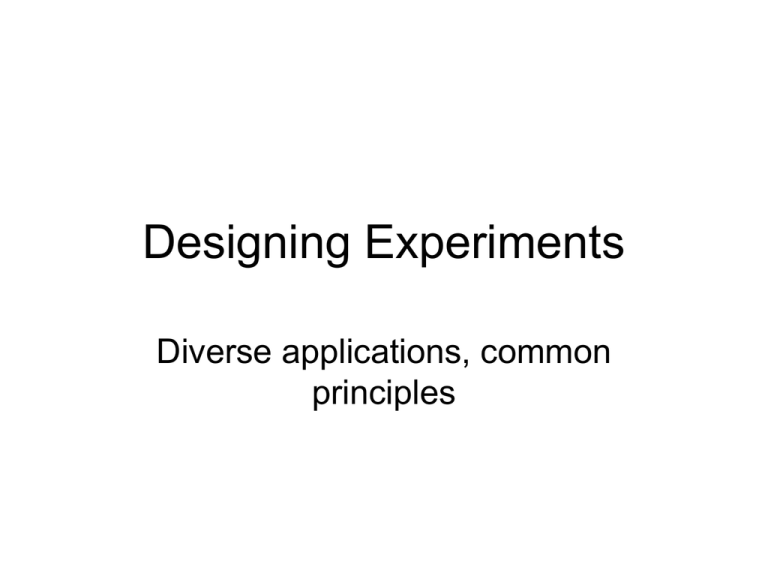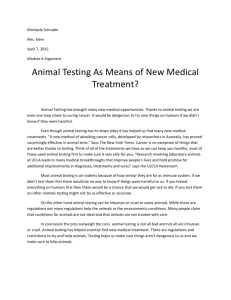Designing Experiments
advertisement

Designing Experiments Diverse applications, common principles The story of an experiment • Aim to find out of ‘Boreproof’ is more resistant to stem borer than M512 • D1: plant a field with Boreproof. • D2: plant a field of Boreproof and another of M512 • Observed damage: 50% (M512), 20% (Boreproof) But we know damage varies widely Objective Comparison Treatments Experimental units • D3: 4 fields of Boreproof and 4 of M512 • Observe: Replication – M512: 50, 60, 40, 35 – Boreproof: 20, 10, 40, 30 Precision • D4: Unit = 10x10 plot. One pair in each field. M512 on the lefthand plot in each, Boreproof on the right Blocking Allocation • Observe • Consistent differences. But effect may not be treatment! • D5: as D4 but with random allocation of treatments to units Field M512 Bore proof 1 50 20 2 20 10 3 30 20 4 60 30 5 60 40 6 20 5 7 0 0 8 40 10 Consistency Confounding Randomisation Same principles • • • • • Field experiments On-farm participatory experiments Lab experiments Social and institutional experiments …. getting it right • Understand and use experimental design principles • Look at papers and reports describing how others have done it • Refer to experienced researchers working on similar topics or methods (different region) • Observe and critique other experiments • Do a pilot experiment • Use imagination! Then… • • • • Think! Use all available sources of help Show design to others and get comments Envisage the data and the way you will use it to reach conclusions. – Draw empty (or expected) tables and graphs • Look at practical implications • Iterate • Think! Concepts and mistakes Objectives •Vague •‘Objective is to compare treatments’ •Too many conflicting objectives in one trial –eg biophyisical and farmer assessment Treatments •Contrasts •Controls •Factorial structure •Quantitative levels Units •Size and shape •Design to measure •Interference •Multiple units •Extra treatments ‘because they might be interesting’ •Omitting suitable control or baseline treatments •Too many levels of quantitative factors •Plots too small for realistic application and measurement of treatments •Non-independent responses •Over-use of split plots Replication •Estimating precision •Controlling precision •Insurance •Extending range of results •Using the ‘usual’ number of reps •Forgetting hidden replication •Insisting on equal replication for all treatments •Forgetting the rules apply to all levels of units •Assuming sub-samples are replicates Site(s) •Single site •Multiple sites •Using the default site •Ignoring requirements of objectives Blocking •Assuming only useful in •Increasing precision by field experiments controlling variation •Limited use of incomplete block designs Randomisation •Assuming only applied to field experiments •Omitting to randomise at some levels of design Management •Every aspect of preparing, implementing, measuring… •Management not appropriate for objectives (eg level of inputs) •Management confounded with treatments •Failure to maximise precision through uniform management The protocol written plan of the experiment The protocol • Written plan of the experiment • A protocol should be: – prepared for every experiment, however small – written, not in your head – shared with others who can help improve it • experience from similar problems, methods, species, ecozones,... – detailed enough for someone else to take over the trial – kept up to date • plans change during the execution • a record of what actually done – archived with the data • kept up to date – plans change during the execution – a record of what actually done • archived with the data The protocol contains... • • • • • • • • • Identification (name of trial, people,...) Justification Objectives Treatments Field layout (sites, blocks, plots) Management Measurements Analysis methods Using the results Check list for planning on-station Agroforestry experiments - rather statistical! Experiments with Farmers: Checklist for Preparing Protocols - better! Good practice in AF field experiments Three changes in research priorities 1. Landscape effects 2. Change processes 3. Participation





